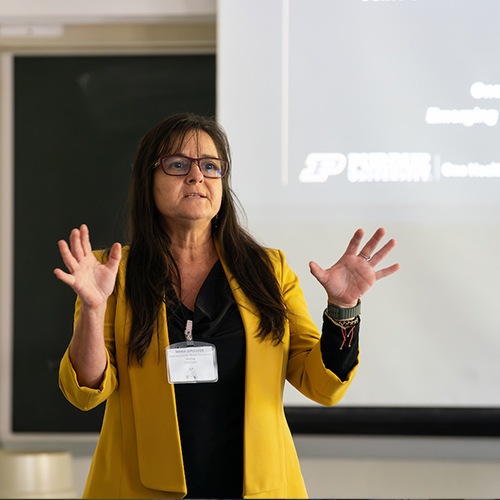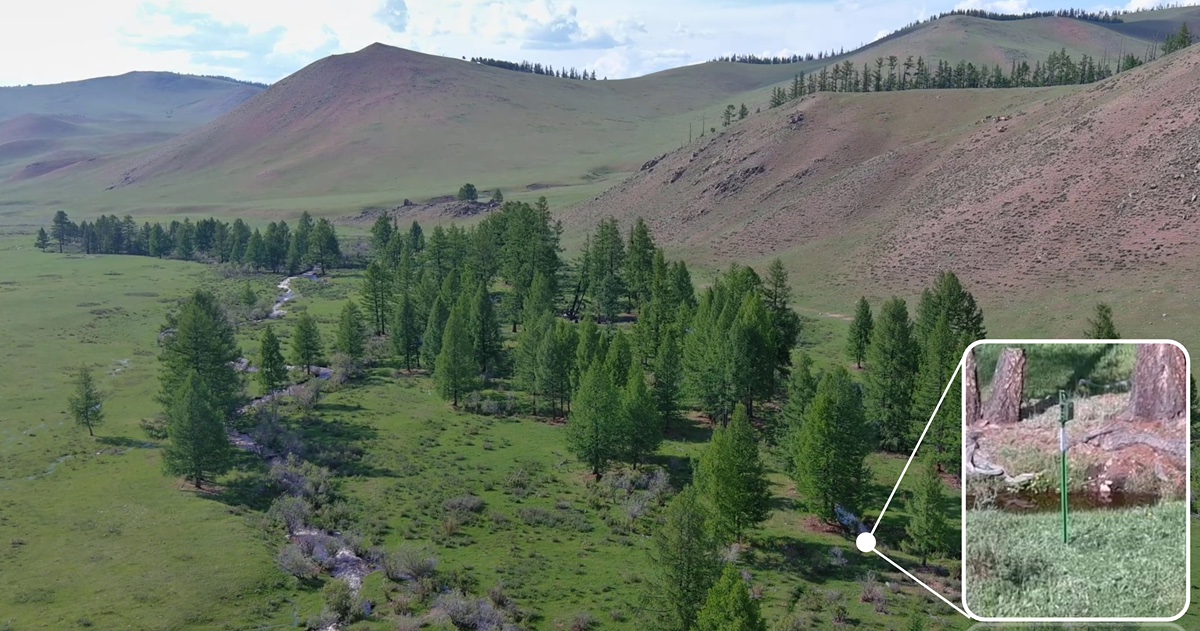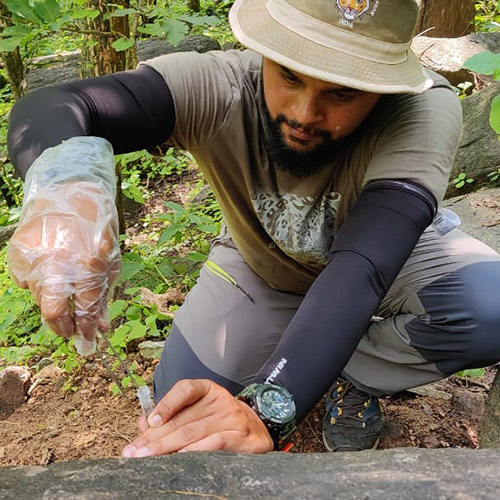FNR Field Reports: Bella Hilaski Recaps Week 3 of the Study Abroad Trip to Sweden, Finland
Throughout the 2025 Sustainable Natural Resources study abroad course in Sweden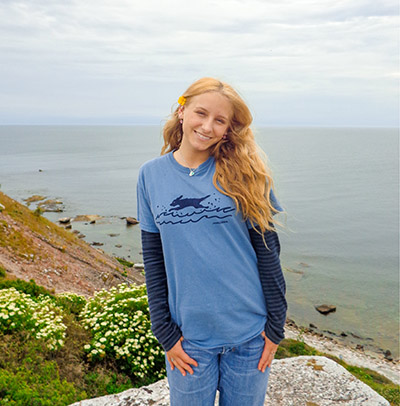 and Finland, FNR students will check in to provide weekly updates on the trip highlights. Bella Hilaski, a junior wildlife major with a minor in aquatic sciences, provides the week 3 report. Hilaski serves on the executive board of Sigma Kappa sorority as director of marketing, where she develops creative communication strategies to engage members and the community in supporting the chapter’s philanthropic efforts. Bella is passionate about conserving wildlife and aquatic ecosystems and is interested in the ways human activities impact natural resources. She participated in the International Resources Study Abroad program to gain a global perspective on conservation and to strengthen her ability to collaborate across cultures and disciplines.
and Finland, FNR students will check in to provide weekly updates on the trip highlights. Bella Hilaski, a junior wildlife major with a minor in aquatic sciences, provides the week 3 report. Hilaski serves on the executive board of Sigma Kappa sorority as director of marketing, where she develops creative communication strategies to engage members and the community in supporting the chapter’s philanthropic efforts. Bella is passionate about conserving wildlife and aquatic ecosystems and is interested in the ways human activities impact natural resources. She participated in the International Resources Study Abroad program to gain a global perspective on conservation and to strengthen her ability to collaborate across cultures and disciplines.
During the three-week Sustainable Natural Resources study abroad course students will examine natural resources broadly defined, including forestry, fisheries, wildlife, agriculture, mining, outdoor recreation, and urban sustainability. They will define, discover, and document examples where sustainability of resource use matters. The course explores the effect of terrain, climate, vegetation, faunal assemblages, social structures and technologies on natural resource use. FNR 46000 is a collaboration of Purdue University, North Carolina State University, and the Swedish University of Agricultural Sciences. American and Swedish students work together to research issues in resource management.
The course is co-taught by FNR's Drs. Tomas Hook and Doug Jacobs as well as other instructors from NC State and SLU.
Bella Hilaski provides her recap of Week 3 of the trip below.
Sunday, July 6th - Northern Gotland and the Island of Fårö
This morning started off bright and early as a local guide met us at our hostel to join us for the day. We boarded a charter bus and headed north toward Fårösund, where we caught a short ferry to Gotland’s northern island, Fårö. Once we arrived, our guide took us through the nature reserve at Verkegards, where we hiked through a forest trail while learning about the island’s unique ecology. He pointed out Swedish whitebeam and oxberry along the trail, as well as other native species like St. John’s Wort, which locals once gathered on Midsummer’s Eve to bring good luck. We also heard about salmbär (dewberries), a sweet, bluish fruit unique to Gotland, often made into jam and served with the island’s famous saffron pancakes.
Our next stop was the Digerhuvud nature preserve, a coastal site known for its towering sea stacks, or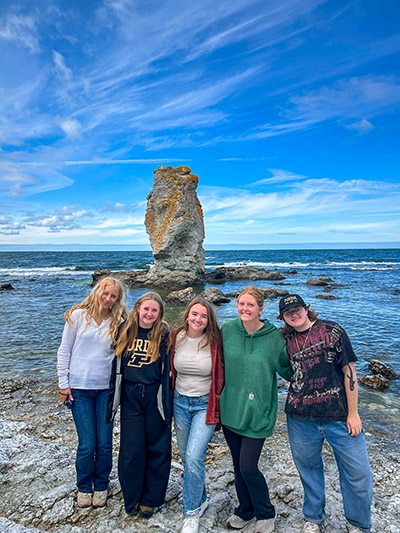 "rauks." The towering limestone rauks are remnants of 430 million year old coral reefs that resisted erosion as Gotland rose from the sea after the last Ice Age. It was surreal standing among the rauks knowing they’ve stood for millennia.
"rauks." The towering limestone rauks are remnants of 430 million year old coral reefs that resisted erosion as Gotland rose from the sea after the last Ice Age. It was surreal standing among the rauks knowing they’ve stood for millennia.
We made another stop at Helgumannen’s fishing village, one of the most iconic and photographed spots on Fårö. Once a hub for herring fishing, the village now consists of 15 traditional wooden huts lined right along the sea. We also got to see a traditional wooden net-drying rack, where fishermen would hang their nets to dry after long days at sea. Our guide also took us to a freshwater spring nearby known as the “Source of the Holy Man,” which draws water from deep within the rock. According to local folklore, the god Thor once chased a giant across the island, and springs burst forth wherever the giant’s feet touched the ground. We even got to drink from the well. The water was cold and clear, with a surprisingly earthy taste, almost like hose water.
We took our bus north to the Langhammars Nature Reserve, where we ate lunch on the shoreline and spotted a pair of swans drifting nearby (which was very surprising to me). On our way back to the hostel, we made one final stop at the Fårö church and cemetery, where the famous Swedish filmmaker Ingmar Bergman is buried. The church itself was beautiful inside and full of history.
Once we were back at the hostel, my friends and I walked to the grocery store to grab a quick dinner. We ended the evening with a campfire at the hostel, roasting marshmallows and making s’mores. It was the perfect way to end such a beautiful day!
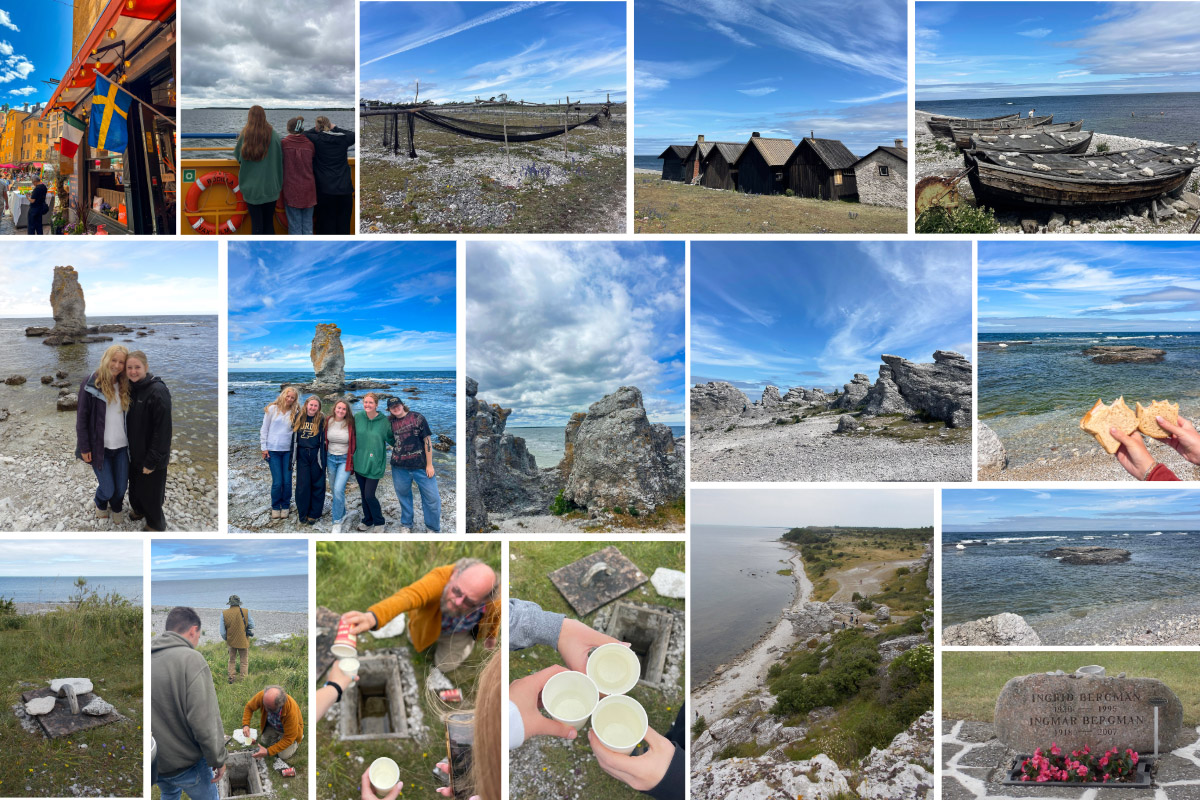 A collage of photos from Northern Gotland and the Island of Fårö
A collage of photos from Northern Gotland and the Island of Fårö Monday, July 7th – Alskog Farm Visit, Gålrum’s Graves, and Coastal Rauks
Today we traveled by bus to the southeastern side of Gotland to visit Ollajvs Farm in Alskog, a family-run sheep and cattle operation. After arriving, we made a quick stop at Gålrum’s Graves, an ancient burial site near the farm. The cemetery has over 100 graves, and some date all the way back to 1500 BCE. What caught my eye the most were the boat-shaped graves, which are large stones arranged in the outline of ships. It was so interesting to see how even thousands of years ago, people on Gotland were so closely tied to the sea. We then returned to the farm, where the farm’s owner took us out to visit the cattle pastures. The cows share the land with the sheep, which helps keep the pastures healthy.
Then we went out to the sheep pasture and met the farm’s herding dog. Watching the dog work was honestly very impressive. After a few quick commands, the dog rounded up the entire flock and brought them right to us.
After the pastures, we gathered in one of the tool barns and had lunch together. Then, we were invited into the owner's home to see their small shop, where they sell handcrafted sheepskin goods made directly from their flock. What stood out to me most was how interconnected everything felt. Raising animals, producing goods, stewarding the land and creating a livelihood from it all. Nothing was wasted and every part of the farm served a purpose.
In the afternoon, we drove all the way down to the southern tip of Gotland to visit Husrygg, a protected coastal reserve. We hiked up along the cliffs and got to see more rauks. On the drive back, we passed by the neighboring islands Lilla Karlsö and Västergarns Utholme, visible right from the road. It felt surreal to look out the window and see the wide expanse of land just sitting out in the sea.
Back at the hostel, a few of us wrapped up the evening with another campfire and a round of s’mores. It was wild to think that in just two days, we’d seen both the northern and southern edges of Gotland, and many places in between.
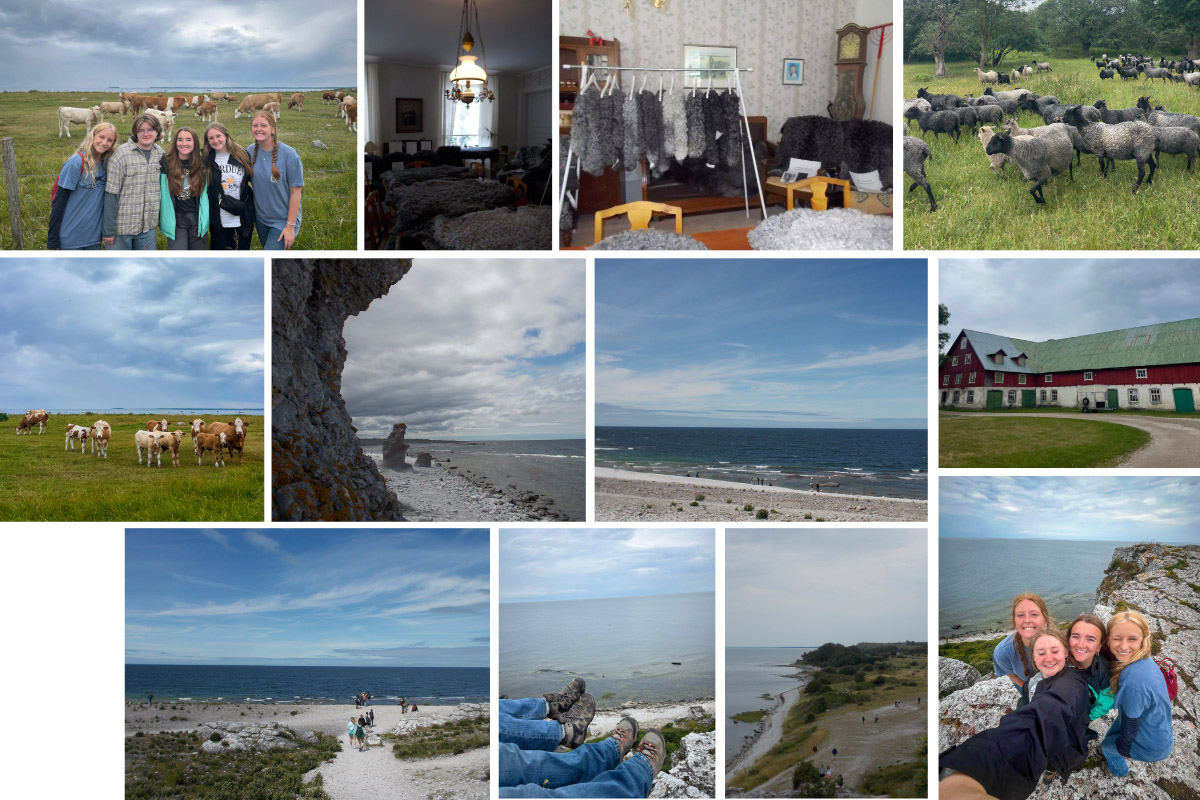 A collage of photos from Bella Hilaski's visits to Alskog farm, Gålrum’s Graves, and coastal rauks in Sweden
A collage of photos from Bella Hilaski's visits to Alskog farm, Gålrum’s Graves, and coastal rauks in Sweden Tuesday, July 8th - Heidelberg Materials and the Lummelunda Cave
This morning we visited the Heidelberg Materials cement factory in Slite. After suiting up in safety vests, hard hats and earpieces, we sat through a presentation about the company’s plans to reduce emissions and shift toward more sustainable production. It was really interesting to learn that this site could become the first carbon-neutral cement plant in the world. They plan to install carbon capture technology that would trap the CO₂ released during cement production and store it deep underground. After the presentation, we toured the facility, walking through hot hallways filled with massive machines, conveyor belts and rotating kilns. One of the highlights was reaching the top floor, where we had a panoramic view of the entire site and the coastline.
In the afternoon, we headed to the Lummelunda Cave on the island’s west side. We stopped in a nearby town for coffee and lunch and explored a bit. Then we watched a short film at the visitors center about how the cave was discovered by three teenage boys who spent years sneaking in and exploring with homemade gear. Inside the cave, the air was cool and damp. The entrance quickly opened into tall chambers filled with stalactites and stalagmites, many still dripping. We saw a fossil of an octopus in the cave wall and pools of water scattered throughout. One of the most unexpected things was a plant growing inside. It was carried in during a flood and now thriving under a grow light they installed. Our guide said the cave is still being explored and could eventually become the largest in Sweden. We got to walk in and hear the history of the two deeper chambers called the Chapel and the Mountain King’s Hall, both discovered by the original teen explorers.
We got back to the hostel in the early afternoon, so a few of us decided to walk back down into the city of Visby. We walked through the market square, stopping at different jewelry stands and doing a little shopping. It was fun to just take our time and explore. For dinner, we found a restaurant that served authentic Swedish meatballs and it was definitely one of the best meals of the trip. Afterward, we popped into a few souvenir shops and continued walking through the cobblestone streets. It was beautiful to walk by all the houses with their detailed architecture and colorful flowers.
Before heading back, we walked through the Visby Cathedral, which was stunning. The inside was wide and airy, with massive stained glass windows. There was a giant organ built into the wall above the entrance, which was beautifully carved and made the whole space feel even more grand.
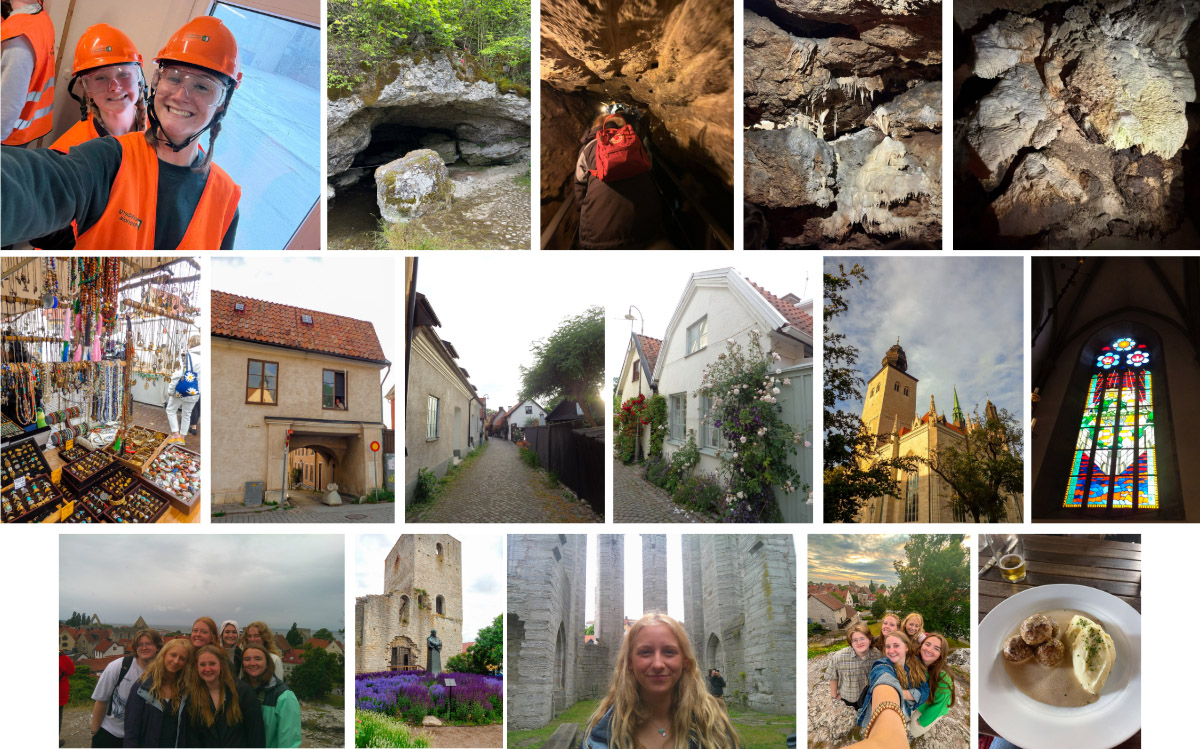 A collage of photos from Bella Hilaski's visits to Heidelberg Materials, the Lummelunda Cave and the city of Visby.
A collage of photos from Bella Hilaski's visits to Heidelberg Materials, the Lummelunda Cave and the city of Visby. Wednesday, July 9th - Traveling to Uppsala
Today was a travel day as we left Gotland and made our way back to mainland Sweden. We packed up early in the morning, left the hostel and took a charter bus to the train station. From there, we boarded a three-hour ferry that took us off the island and back toward Stockholm. Once we arrived in Stockholm, we took the train back to Uppsala and checked into our hotel. From that point on, there were no more planned activities for the rest of the trip, since our focus had shifted to finishing our group projects, which we were presenting Friday. A lot of people spent the afternoon working and preparing, including our group. Afterward, we went out to a local restaurant for dinner, and, when we got back to the hotel, we ended the night talking around the breakfast lounge tables before heading to bed. It wasn’t a big sightseeing day, but after such an adventurous week, it felt good to slow down and recharge!
Thursday, July 10th - A Day in Stockholm
Today was a free day, so my friends and I took the opportunity to spend the afternoon exploring Stockholm. We started our morning with the hotel’s continental breakfast to fuel up before catching the train. After a 45-minute ride, we arrived in the city and headed straight for Old Town Stockholm, where the streets are lined with tall, colorful buildings and filled with souvenir shops, cafés and street vendors.
We spent the early afternoon browsing for gifts for our friends and family, like sweatshirts, magnets and a Dala horse, which is a famous symbol of Sweden. After shopping, we continued walking through the cobblestone streets until a coffee shop caught our eye. We grabbed drinks and pastries then sat outside at tables facing the market square. It was the perfect spot to talk, people watch and soak in the energy of the city! Stockholm is filled with dessert stands, especially gelato, waffles and churros. I stopped at one and got some cinnamon-dusted churros, which were perfectly crispy and sweet. Just before catching the 5 o’clock train back to Uppsala, my friend and I decided to get ear piercings at a local tattoo parlor. It was such a fun memory to mark the end of our trip.
Once we got back to Uppsala in the evening, we regrouped with our classmates and started preparing for tomorrow’s group presentations. My group focused on energy systems in Sweden, so I spent the evening researching hydropower, especially looking into Vattenfall, which we had visited at the beginning of our trip. We cooked dinner in the hostel kitchen and then spent most of the night finalizing slides and practicing. Today was definitely a great balance of enjoying our final free time and pulling everything together for the end of the program.
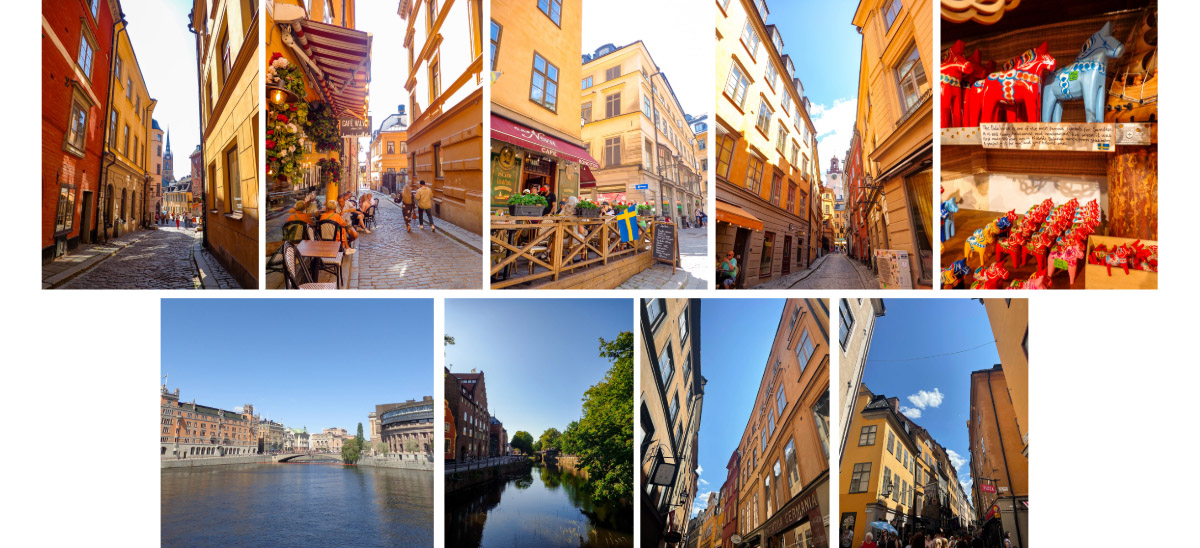 A collage of images from Bella Hilaski's visit to Stockholm, Sweden.
A collage of images from Bella Hilaski's visit to Stockholm, Sweden. Friday, July 11th - Group Presentations and Our Last Day
Presentation day! We woke up early, grabbed breakfast at the hotel and headed out around 8 a.m. to walk to the Radisson Blu, where we would be giving our final group presentations in one of their conference rooms.
Each group presented on a different topic related to Sweden’s strive for sustainability: Fisheries Management, Ecotourism, Aquatic Habitats and Energy Systems. Each group made their presentation engaging and fun with creative formats and having the audience participate. One even had us act as policymakers. It was a really meaningful way to reflect on all the things we learned as well as all the places we experienced along the way. By the time it was our turn after lunch, I wasn’t even nervous. At this point, the entire room felt like a group of close friends because we had spent so much time together over the past few weeks. My group presented on Sweden’s energy systems and we decided to turn it into a game show. It kept things upbeat and entertaining, and, honestly, made the presentation really fun to give.
We had the rest of the day to ourselves after presentations. I went back to the hotel to pack up my luggage as we all had to be out of the hotel by 11 the following morning. A big group of us decided to meet up for a casual picnic dinner. Some friends and I stopped by a kebab stand, which had become our favorite type of street food throughout our trip, and picked up food to bring with us. We carried our dinners to a grassy field overlooking a chapel, where everyone was sitting in the grass, chatting and soaking in our last evening together. To end the night, a few of us went out to a restaurant and ran into one of our professors. We sat together for a while and just reflected on our trip and all of the places we experienced.
As the day was ending, it really hit me how much this trip had meant to me. I wasn’t just saying goodbye to Sweden. I was saying goodbye to a group of people who made the experience so special. It felt incredibly bittersweet. We’d shared so many laughs, long days and unforgettable moments, and suddenly it was all coming to an end. I kept thinking about how different everything would feel once we were all back home, especially since half of our group went to a different university. But even though we were heading off in different directions, I knew this trip would stay with all of us way after. I’m so glad I did it and if I had the chance, I’d truly do it all over again.
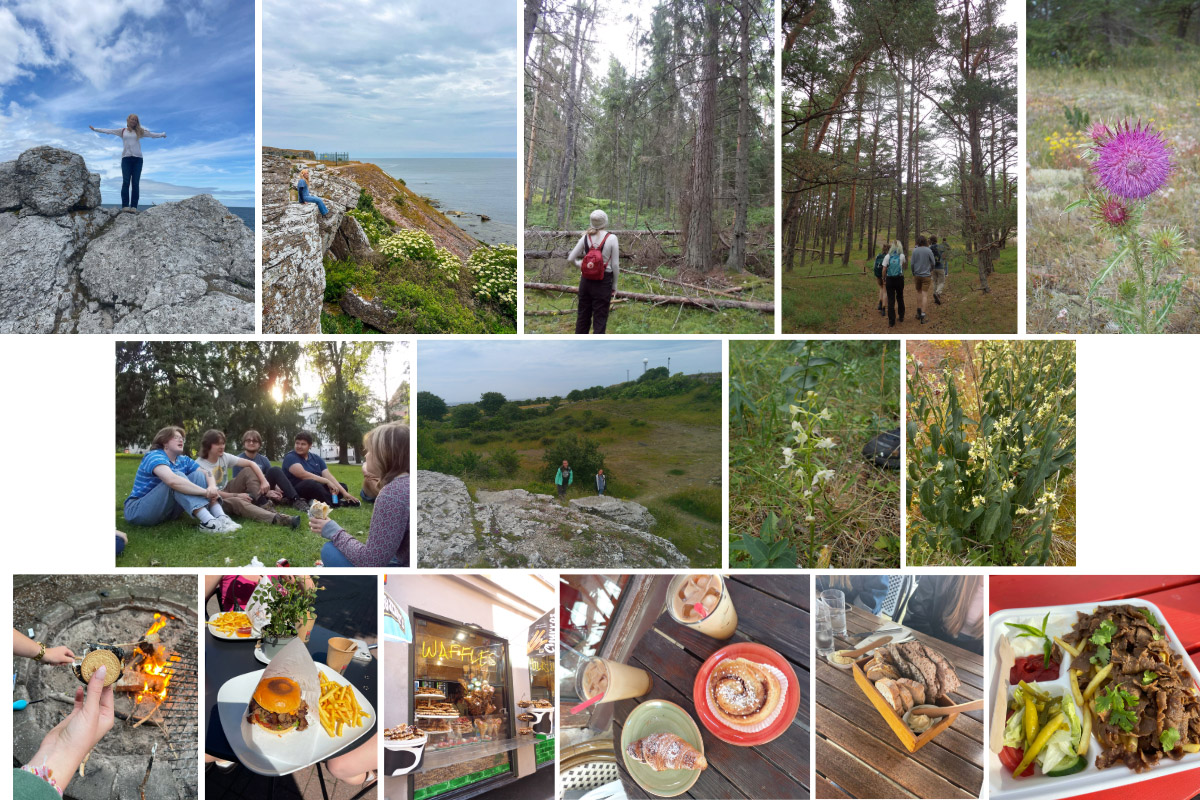 A collage of photos from Bella Hilaski's study abroad trip to Sweden and Finland, including food, flowers and friends.
A collage of photos from Bella Hilaski's study abroad trip to Sweden and Finland, including food, flowers and friends. 



